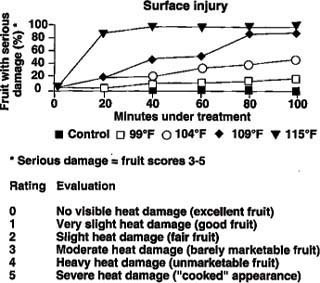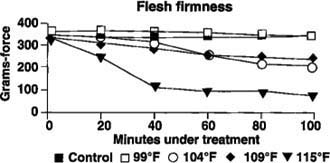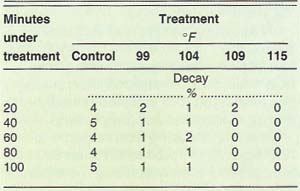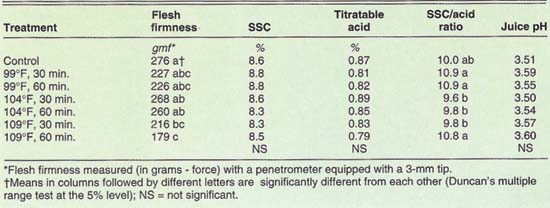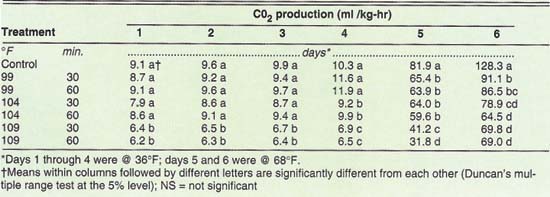All Issues
To control postharvest decay and insects, moist heat treatments of strawberries are studied
Publication Information
California Agriculture 46(2):26-28.
Published March 01, 1992
PDF | Citation | Permissions
Abstract
Experiments with moist heat treatments of 'Chandler' strawberries at temperatures ranging from 99° to 115° F for durations of 20 to 100 minutes showed that fruit heated up to 104° F for 30 minutes were still judged marginally marketable. Although some decay can apparently be controlled with heat, it is doubtful that fruit can tolerate the amount of heat required for insect quarantines.
Full text
In response to increasing public concern over the use of agricultural chemicals, alternative ways to control postharvest decay and insect damage are being studied, including the treatment of strawberries with moist heat. Currently, the most common methods of strawberry decay control are fast cooling and carbon dioxide treatments. The purpose of this experiment was first to determine what temperatures of moist heat treatments ‘Chandler’ strawberries could withstand, and then to examine whether those heat treatments could effect insect control. While measuring tolerance levels, we also measured decay control.
Postharvest heat treatments are currently used to control decay in papayas, and they have been used experimentally to control disease and insect infestations in mangoes, avocados, bananas, stone fruits, strawberries and raspberries. Treatments in strawberries have had mixed results. Heat can be applied by exposing fruits to hot water, vapor heat (water-saturated hot air), hot dry air and radiation (infrared and microwave). Of all the possible treatments, use of hot water has become the most common. Strawberries, however, do not tolerate immersion in water, and dry heat quickly desiccates them. Moist heat, therefore, was selected as the most promising method for heat-treating ‘Chandler’ strawberries.
Materials and methods
In an initial screening, fruit were heated to 99°, 104°, 109° and 115°F for 20, 40,60,80 and 100 minutes at each temperature level. In subsequent tests, fruit were heated at 99°, 104° and 109°F for 30 and 60 minutes each. Heating rooms were maintained at 91 to 94% relative humidity as confirmed by a wet-dry bulb electric psychrometer. Fruit pulp temperatures were measured by thermocouple insertion into extra fruit.
Following the heat treatment, all fruit were exposed to 32°F air for rapid cooling and remained overnight at that temperature. Fruit were then moved to 36°F for 24 hours, 41°F for 48 hours and, finally, 68°F for 24 hours to simulate the temperature patterns expected in commercial transit, distribution and retail shelf display.
In the first screening, crates were divided in half — half for tested fruit, half for controls. In all subsequent tests, pickers were selected, and each picker was asked to prepare one complete replication to avoid problems of picker variability. (Some pickers may harvest more mature or less mature fruit.) Each treatment was replicated five times in a completely randomized design. Fruit samples were evaluated (1) immediately after heat treatment, (2) after overnight storage at 32°F and (3) after the simulated commercial exposure.
Fruit were monitored for appearance, flesh firmness, soluble solids content (SSC) and titratable acidity. Fruit appearance was scored by rating each fruit on a scale of 0 to 5:0 = no visible surface injury, 5 = severe surface injury (light-colored, glistening and water-soaked appearance). Fruit scoring 3 or higher were considered seriously damaged. Fruit flesh firmness was measured on opposite sides of each fruit with a 0- to 500-gram firmness tester. SSC and titratable acidity were measured by refractometer and titration with standardized sodium hydroxide. Respiration and ethylene studies were initiated as soon as the fruit were moved to 36°F, and the fruit remained at 36°F until the final transfer to 68°F. (The transfer of fruit to a 41°F treatment was done only in the commercial transit study, and not in the respiration study.) This variation in temperature pattern was used to avoid development of excessive fungal decay that could otherwise confuse the measurements of carbon dioxide (CO2) and ethylene (C2H4) production.
Time/temperature effects
Appearance. Immediately after the 32°F overnight holding, fruit heated at 99°, 104° and 109°F had injury scores ranging from 2 to 3, except that fruit heated at 109°F for 100 minutes scored 4 (data not shown). All fruit heated at 115°F scored 5, except those exposed for 20 minutes, which scored 3 to 4. No statistical analysis was made of these data.
Following simulated commercial exposure, all fruit exposed to 99°, 104° and 109°F had injury scores averaging 2 to 3, except those held at 109°F for 80 to 100 minutes, which scored 4 (data not shown). All fruit exposed to 115°F at all durations scored 4 to 5. All of the control fruit were of excellent to good condition, with injury scores ranging from 0.5 to 1.2.
Fruit scoring 3,4 and 5 appeared to have serious surface damage. Fruit exposed to 99°, 104°, 109° and 115°F for 20 to 100 minutes developed 3 to 18%, 17 to 50%, 17 to 93% and 88 to 98% serious damage, respectively, while control fruit had less than 1% serious damage (fig. 1). In general, at any temperature, fruit surface injury level increased as exposure time increased.
Flesh firmness, SSC and titratable acidity. Fruit flesh firmness and treatment temperature varied inversely. Fruit exposed to 99°F for 20 to 100 minutes were firmer than control fruit (fig. 2). Firmness of treated fruit declined from above 360 grams-force (gmf) at 99°F to less than 100 gmf at the 115°F treatment. Firmness of control fruit averaged around 290 to 350 gmf. At 115°F, there was an inverse relationship between flesh firmness and exposure time.
SSC ranged from 6.0 to 7.7%; titratable acidity ranged from 0.65 to 0.88% for all fruit (data not shown). No statistical analyses were made.
Decay. Although no fungal inoculations were made, notes were taken on the amount of decay present. The 40 fruit used to score quality were also examined for decay. Control fruit generally had a higher incidence of decay than treated fruit (table 1). Fruit held at 109°F for more than 20 minutes and fruit held at 115°F had no decay. Heat appeared to lessen decay development.
TABLE 2. The effects of postharvest heat treatments on some characteristics of ‘Chandler’ strawberries as measured after overnight cooling (32°F)
Response to heat
Based upon results of the screening test, it was decided to conduct future tests at temperatures between 99° and 109°F for up to 60 minutes.
Overnight cooling. After overnight cooling at 32°F (table 2), fruit flesh firmness gradually declined as temperatures and exposure durations increased, but only fruit subjected to 109°F were significantly softer than control fruit. Measurements of SSC, titratable acid and juice pH showed no significant differences among either treatments or controls. A few minor differences in the SSC/acid ratio among treatments were noted, but none was significantly different from the control. The level of fruit surface injury appeared to increase as temperature and exposure time increased, but this was not quantified.
Commercial distribution. When fruit were evaluated after simulated commercial distribution at 32° + 36° + 41° + 68°F (see table 3), they were judged according to the following characteristics:
(1) Appearance. Treatment temperature and heat damage were directly related; the higher the temperature the greater the heat damage. Fruit treated at 104°F for 60 minutes and at 109°F for 30 and 60 minutes developed significantly greater heat damage than fruit in other treatments, and the average scores of 2.6 to 3.0 showed that the fruit had incurred serious damage.
Fruit scoring 3,4 and 5 were judged seriously damaged. Fruit exposed to 104°F for 60 minutes and to 109°F for 30 and 60 minutes had significantly greater injury than the control fruit. More than 60% of the fruit exposed to 109°F had serious damage, compared with less than 30% for fruits exposed to treatments of 104°F for 30 minutes and about 17% for control fruit.
TABLE 3. The effects of postharvest heat treatments on postharvest performance characteristics of ‘Chandler’ strawberries as measured after simulated transport movement (32°+36°+41°+68°F)∗
(2) Flesh firmness, SSC, titratable acid, SSC/acid ratio and juice pH. There were no statistical differences in fruit firmness among the treatments, but all heat-treated fruit were slightly softer than control fruit. There were no statistical differences among the treatments concerning acid, SSC/acid and juice pH. SSC was variable, but 109°F-treated fruit were lower in SSC than control fruit. The titratable acidity of fruit treated at 109°F was numerically much lower than the others, and the SSC/ acid ratio was numerically higher in heat-treated fruit than in the control.
(3) Decay. There was moderately less decay in fruit from all heat treatments than in the control fruit (about 6 to 9% decay in treated fruit, compared with 17% in control fruit). High temperatures were able to suppress fungal development. These were random infections and differences were not significant.
If one could expect this level of differences in commercial use, then shippers might be able to tolerate up to a 10% increase in serious damage as a result of heat treatment. On that basis, the 99°F treatments may be acceptable, 104°F/30 minutes treatment marginal and the other treatments unacceptable.
(4) Respiration and ethylene production. During a holding period of 4 days at 36°F plus 2 days at 68°F, there was an inverse relationship between heat treatment and CO2 production: the higher the treatment temperature, the lower the CO2 production (table 4). During the 6 days of readings, fruit in the 109°F treatments produced significantly less CO2 than other fruit, including the control fruit, and by the fourth day fruit treated at 104°F produced significantly less CO2 than control fruit. By the fifth and sixth day (68°F), all heat-treated fruit produced significantly less CO2 than control fruit. There was a gradual, but slight, rise in CO2 production in all samples over the 4 days at 36°F and a large increase while fruit were at 68°F. The differences between fruit from the 109°F treatments and fruit from other treatments increased with time. No ethylene production could be measured while fruit were at 36°F, and after fruit were moved to 68°F, ethylene evolution occurred only in the control fruit (data not shown).
TABLE 4. The effects of postharvest heat treatments on respiration of 'Chandler' strawberries, during 4 days @ 36°F plus 2 days @ 68°F
Summary
A screening test showed that fruit treated at 99° and 104°F for up to 100 minutes suffered less serious damage than fruit treated at 109° and 115°F. Strawberries heated to 115°F were too severely damaged for other test comparisons.
In tests measuring fruit response to heating, fruit exposed to 109°F for 30 to 60 minutes consistently suffered more heat damage and lower respiration and ethylene production than fruit from lower temperature treatments or control fruit. Fruit exposed to the highest temperatures and durations developed highest injury scores and also had the highest percentages of serious damage. All heat treatments lowered the respiration and ethylene evolution rates of the fruit and this became significant for all treatments when monitored at 68°F. These reductions occurred even in fruit receiving the lowest temperature and shortest duration treatments where little evidence of physical injury was seen.
Heat-treated fruit were softer, less acidic and less decayed than control fruit, but differences were not significant. Generally, we found no significant differences in SSC, titratable acidity, SSC/acid ratio or juice pH among the treatments.
Although fruit exposed to 99°F for 30 and 60 minutes and 104°F for 30 minutes were not significantly different from control fruit, they had numerically greater surface injury than the control fruit, but suffered only half as much serious injury as fruit in the 109°F treatment. Potential benefits for the heat treatment in reducing decay or controlling insects would have to be balanced against fruit injury losses resulting from the treatment. Because of the limited tolerance of ‘Chandler’ strawberries to heat exposure, we doubt that this fruit would tolerate the use of heat for insect quarantine treatment.
Other studies will be required to evaluate treatment tolerance of other strawberry varieties, and the potential for using postharvest heat treatment within the limits of fruit tolerance as a supplement or as an alternative to chemical treatment for insect and/or decay control.




